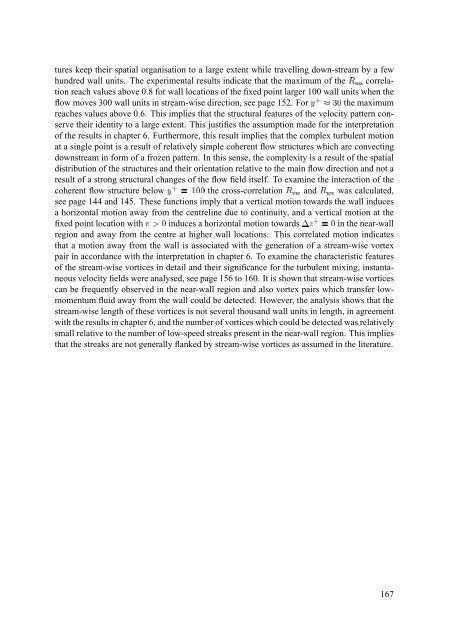The significance of coherent flow structures for the turbulent mixing ...
The significance of coherent flow structures for the turbulent mixing ...
The significance of coherent flow structures for the turbulent mixing ...
You also want an ePaper? Increase the reach of your titles
YUMPU automatically turns print PDFs into web optimized ePapers that Google loves.
¡<br />
¿<br />
tures keep <strong>the</strong>ir spatial organisation to a large extent while travelling down-stream by a few<br />
hundred wall units. <strong>The</strong> experimental results indicate that <strong>the</strong> maximum <strong>of</strong> <strong>the</strong> ªS·· correlation<br />
reach values above 0.8 <strong>for</strong> wall locations <strong>of</strong> <strong>the</strong> fixed point larger 100 wall units when <strong>the</strong><br />
<strong>flow</strong> moves 300 wall units in stream-wise direction, see page 152. For ¹ » %[Â <strong>the</strong> maximum<br />
reaches values above 0.6. This implies that <strong>the</strong> structural features <strong>of</strong> <strong>the</strong> velocity pattern conserve<br />
<strong>the</strong>ir identity to a large extent. This justifies <strong>the</strong> assumption made <strong>for</strong> <strong>the</strong> interpretation<br />
<strong>of</strong> <strong>the</strong> results in chapter 6. Fur<strong>the</strong>rmore, this result implies that <strong>the</strong> complex <strong>turbulent</strong> motion<br />
at a single point is a result <strong>of</strong> relatively simple <strong>coherent</strong> <strong>flow</strong> <strong>structures</strong> which are convecting<br />
downstream in <strong>for</strong>m <strong>of</strong> a frozen pattern. In this sense, <strong>the</strong> complexity is a result <strong>of</strong> <strong>the</strong> spatial<br />
distribution <strong>of</strong> <strong>the</strong> <strong>structures</strong> and <strong>the</strong>ir orientation relative to <strong>the</strong> main <strong>flow</strong> direction and not a<br />
result <strong>of</strong> a strong structural changes <strong>of</strong> <strong>the</strong> <strong>flow</strong> field itself. To examine <strong>the</strong> interaction <strong>of</strong> <strong>the</strong><br />
<strong>coherent</strong> <strong>flow</strong> structure below ¹&» ¬<br />
see page 144 and 145. <strong>The</strong>se functions imply that a vertical motion towards <strong>the</strong> wall induces<br />
a horizontal motion away from <strong>the</strong> centreline due to continuity, and a vertical motion at <strong>the</strong><br />
fixed point location ã with induces a horizontal motion ×pû ¬\ towards in <strong>the</strong> near-wall<br />
region and away from <strong>the</strong> centre at higher wall locations. This correlated motion indicates<br />
that a motion away from <strong>the</strong> wall is associated with <strong>the</strong> generation <strong>of</strong> a stream-wise vortex<br />
pair in accordance with <strong>the</strong> interpretation in chapter 6. To examine <strong>the</strong> characteristic features<br />
<strong>of</strong> <strong>the</strong> stream-wise vortices in detail and <strong>the</strong>ir <strong>significance</strong> <strong>for</strong> <strong>the</strong> <strong>turbulent</strong> <strong>mixing</strong>, instantaneous<br />
velocity fields were analysed, see page 156 to 160. It is shown that stream-wise vortices<br />
can be frequently observed in <strong>the</strong> near-wall region and also vortex pairs which transfer lowmomentum<br />
fluid away from <strong>the</strong> wall could be detected. However, <strong>the</strong> analysis shows that <strong>the</strong><br />
stream-wise length <strong>of</strong> <strong>the</strong>se vortices is not several thousand wall units in length, in agreement<br />
with <strong>the</strong> results in chapter 6, and <strong>the</strong> number <strong>of</strong> vortices which could be detected was relatively<br />
small relative to <strong>the</strong> number <strong>of</strong> low-speed streaks present in <strong>the</strong> near-wall region. This implies<br />
that <strong>the</strong> streaks are not generally flanked by stream-wise vortices as assumed in <strong>the</strong> literature.<br />
<strong>the</strong> cross-correlation ªSÔÙ and ªSÙ¥Ô was calculated,<br />
167
















